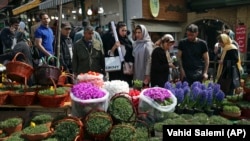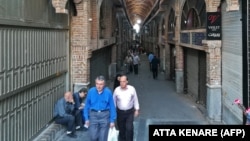The wave of protest and unrest in Tehran’s retail commercial centers this week highlighted the role of the bazaar in social and political change in Iran.
Although the Grand Bazaar was a key player in in the events of this week, which quickly turned from unhappiness about worsening economic conditions to audacious calls for political change, it is good to note that protests started from Tehran’s cell phone market on Sunday.
The bazaar is no longer the intertwined labyrinths of crossroads and cubicles under arched roofs. Part of the modern bazaar runs its business from high-rise buildings and vast malls in downtowns, as well as the more affluent parts of major Iranian cities.
One can still see traders haggling and swearing over prices in the narrow alleyways also known as suq, but most of the business in the bazaar takes place over the phone, often on the back of motorcycles that replace cars and buses in the traffic jams of downtown Tehran.
Young traders buy and sell goods without seeing them. Imports often change hands before leaving customs, as it was the case involving millions of dollars’ worth of cell phones sold at a high price by profiteers who had imported them with low exchange rate dollars allocated by the government. The case was disclosed by none other than ITC Minister Mohammad Javad Azari Jahromi.
Bazaar, one of the most significant and powerful players in the Iranian politics since late 19th century, always politically aligned itself with conservative clerics, and disdained extremism as something which is bad for business.
Tehran’s Grand Bazaar was politically active against Qajar kings, the Pahlavi dynasty, and at times against democratically minded politicians such as Prime Minister Mohammad Mossadeq and Foreign Minister Hossein Fatemi in the early 1950s.
Throughout the 20th century, the bazaar funded or organized mobs against political establishments and ideologies such as communism and liberalism. Parts of the bazaar, are suspected of having a hand in the assassination of politicians such as Prime Ministers Hajali Razmara and Hassanali Mansour in the 1950s and 60s through hardline political organizations Fadayan Eslam and the Islamic Coalition Society.
The bazaar also partly funded Ayatollah Rouhollah Khomeini’s Islamic Revolution in 1979. However, the alliance between the bazaar and the Islamic Republic did not last long as the war with Iraq, and the seizure of US embassy in Tehran were deemed bad for business. The government controlled the economy and left very little if any room for the Bazaar to be a major economic player.
In the meantime, the Bazaar had lost its most important political ally when the liberal Freedom Movement, then, led by Prime Minister Mehdi Bazargan fell out with Khomeini and the movement became part of the opposition. For nearly a decade, a soviet-style centralized economy was imposed on the country. In the meantime, many at the bazaar lost their sons to the Islamic Republic violent and disproportionate system of justice in the 1980s.
For less than half a decade the bazaar tried to regain its status after President Akbar Hashemi-Rafsanjani took office in the late 1980s, but as the Islamic Revolution Guards Corps (IRGC) hijacked the lion’s share of Iranian economy in mid 1990s, the bazaar became alienated and the regime no longer saw it as its most important political partner.
The bazaar’s political partnership with the ruling clerics also effectively ended at the same time. Clerics who depended on the bazaar for longer than a century, now had new sources of income. They owned the government, and thought they also owned the IRGC and its vast financial conglomerate.
The demonstrations that started at the cell phone market on June 24, first swept across the two politically active bazaars in Tehran and Tabriz, and then spread to other cities. Political slogans echoed once again under the arched roofs of Iranian bazaars as far as Kermanshah at the border with Iraq and Qeshm Island in the Persian Gulf.
The bazaar may be once again a force to be reckoned with in the Iranian political landscape. A force with a proven track record of bringing about political change. “When the Bazaar speaks, everyone listens,” goes a wise saying.
The bazaar in turn will be watching reactions coming from Tehran’s Pasteur Avenue, where the offices of President Hassan Rouhani and Supreme Leader Ayatollah Khamenei are located.







